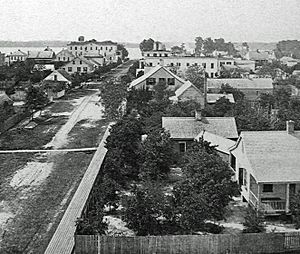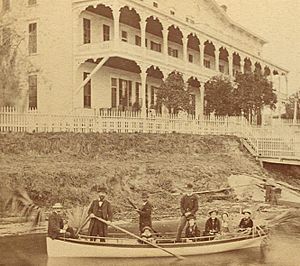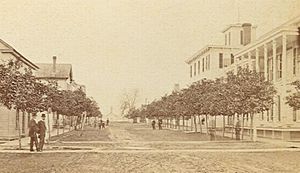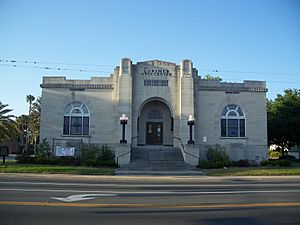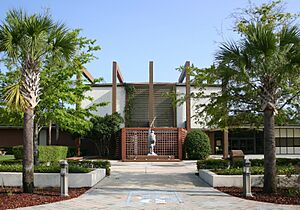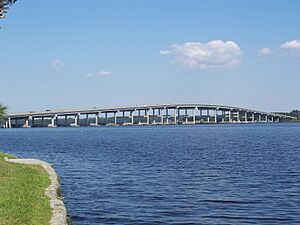Palatka, Florida facts for kids
Quick facts for kids
Palatka, Florida
|
||
|---|---|---|
| City of Palatka | ||
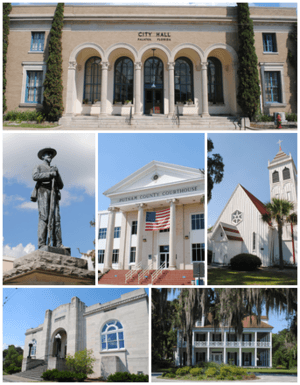
Images top, left to right: City Hall, Confederate Memorial, Putnam County Courthouse, St. Mark's Episcopal Church, Larimer Memorial Library, Bronson-Mulholland House
|
||
|
||
| Nickname(s):
P-Town
|
||
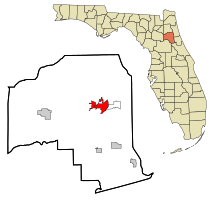
Location in Putnam County and the state of Florida
|
||
| Country | United States | |
| State | Florida | |
| County | Putnam | |
| Settled | 1821 | |
| Incorporated | January 8, 1853 | |
| Government | ||
| • Type | Commission-Manager | |
| Area | ||
| • Total | 9.76 sq mi (25.27 km2) | |
| • Land | 9.76 sq mi (25.27 km2) | |
| • Water | 0.00 sq mi (0.00 km2) 7.70% | |
| • Micropolitan | 827 sq mi (2,142 km2) | |
| Elevation | 16 ft (5 m) | |
| Population
(2020)
|
||
| • Total | 10,446 | |
| • Density | 1,070.62/sq mi (413.36/km2) | |
| • Micropolitan | 72,893 | |
| Time zone | UTC-5 (EST) | |
| • Summer (DST) | UTC-4 (EDT) | |
| ZIP codes |
32177-32178
|
|
| Area code(s) | 386 | |
| FIPS code | 12-53875 | |
| GNIS feature ID | 0288381 | |
| Website | palatka-fl.gov | |
Palatka (pronounced pə-LAT-kə) is a city in Putnam County, Florida, United States. It is the main city in the Palatka Micropolitan Statistical Area, which is home to about 72,893 people. Palatka is also part of the larger Jacksonville—Kingsland–Palatka, FL-GA Combined Statistical Area.
The city is home to St. Johns River State College, the headquarters for the St. Johns River Water Management District, and Ravine Gardens State Park. Palatka is known for its fun local events like the Florida Azalea Festival and the Blue Crab Festival. In 2020, the city had a population of 10,446 people.
Contents
History of Palatka
Long ago, the Palatka area was home to the Timucua people. Two Timucuan tribes lived here, led by chiefs Saturiwa and Utina. They were skilled at fishing for bass and mullet. They also hunted deer, turkeys, bears, and opossums. Some Timucua people farmed crops like beans, corn, melons, squash, and tobacco. Sadly, European diseases and wars caused these tribes to disappear by the mid-1700s. The last remaining people moved to Cuba with the Spanish in 1763. This happened when Spain gave Florida to Great Britain after the Seven Years' War.
Later in the 1700s, parts of the Creek and other tribes moved to Florida. They formed the Seminole tribe. They called this place Pilo-taikita, which means "crossing over" or "cows' crossing." This spot was important because the St. Johns River becomes narrower and shallower here.
In 1767, an English gentleman named Denys Rolle started a large farm called Rollestown. It was on the east side of the St. Johns River. He hoped to create a perfect community, bringing settlers from London. But these settlers were not used to hard work or the warm Florida climate, so they left. Rolle then brought enslaved people from West Africa to work on the farm. They raised chickens, hogs, goats, and sheep. They also grew cotton, indigo, citrus, and made turpentine to send to England.
Rolle built a big house and a village. But his "ideal society" had many problems. In 1770, an unhappy manager sold over 1,000 of Rolle's cattle and ran away with the money. Rolle tried to make the farm work, but it never did well. When Spain took control of Florida again in 1783, Rolle left. He moved his belongings, animals, and enslaved people to an estate in the Bahamas. The area in East Palatka is still called Rollestown today.
Early Settlements and Conflicts
As Florida changed hands, so did the ownership of Pilo-taikita, which became known as Pilatka. In 1774, a naturalist named William Bartram saw a Native American village on the west bank. But it was empty by the time European Americans came to settle. The city of Palatka began in 1821. After the United States bought Florida in 1821, Nehemiah Brush started a ferry service. He bought a large piece of land in 1826. This spot became a place where goods were sent to new settlers.
American settlers wanted more land, which led to problems with the Seminole people. In 1833, the government tried to move the Seminole tribe west of the Mississippi River. This started the Second Seminole War. In 1835, the Seminole attacked and burned Pilatka. The U.S. Army saw that this spot was important for controlling the St. Johns River. So, in 1838, they built Fort Shannon. It had soldiers, supplies, and a hospital. By 1842, the Seminole were pushed out of the area. The army left Fort Shannon in 1843. Settlers then used the army's piers and buildings to help the town grow. By 1847, Pilatka was growing fast. In 1849, Putnam County was created, and Pilatka became its main city. It officially became a city on January 8, 1853.
Growth and Challenges
In the 1850s, Florida became a popular place for people from the cold North to visit in winter. Steamboats brought more and more visitors up the river. People enjoyed sailing, fishing, rowing, walking, riding horses, and hunting.
The Civil War stopped this tourism. During the war, Palatka was poor and mostly empty. On October 7, 1862, a Union ship fired shells over the town. Mary Boyd asked the Union commander to spare Palatka, saying the soldiers were not from the town. He agreed.
A famous resident during the war was Confederate spy Lola Sánchez. She became a spy after her father was wrongly accused and jailed by the Union Army. Union officers stayed in her family's home. One day, Sánchez overheard them planning a raid. She warned the Confederate forces. Because of her warning, the Confederates surprised and captured the Union troops in the Battle of Horse Landing.
After the war, tourists returned. New hotels were built, like the Putnam House and the Larkin House. Steamboats traveled up the Ocklawaha River and the St. Johns River. Industries like logging, raising cattle and hogs, and orange groves grew. On May 24, 1875, the post office changed the spelling to Palatka. This helped avoid confusion with another town called Picolata.
By the 1880s, several railroads came through Palatka, making it an important train stop. But on November 7, 1884, a huge fire destroyed much of Palatka. Tourists arriving that season had nowhere to stay, so they traveled further south. This fire caused tourism to slowly move away from Palatka. The city lost its importance in trade and shipping to Jacksonville, which was on the coast. However, Palatka rebuilt its downtown with brick buildings that were more fireproof.
In 1893, the Wilson Cypress Company bought a sawmill in Palatka. It became a huge employer, processing cypress wood. At its busiest, it was the second largest cypress mill in the world. But it closed in 1944. The Great Freeze of 1894 and 1895 destroyed Palatka's orange groves for five years. Today, tourism is still important to the city.
Geography
Palatka is located at 29°38′N 81°39′W / 29.633°N 81.650°W. The city covers about 7.5 square miles (19.4 square kilometers). It is about 16 feet (4.8 meters) above sea level. Palatka is in the southern part of the Lower St. Johns River basin.
 |
Keystone Heights | Green Cove Springs | St. Augustine |  |
| Gainesville | Palm Coast | |||
| Ocala | Crescent City | Daytona Beach |
Population and People
| Historical population | |||
|---|---|---|---|
| Census | Pop. | %± | |
| 1860 | 613 | — | |
| 1870 | 720 | 17.5% | |
| 1880 | 1,616 | 124.4% | |
| 1890 | 3,039 | 88.1% | |
| 1900 | 3,301 | 8.6% | |
| 1910 | 3,779 | 14.5% | |
| 1920 | 5,102 | 35.0% | |
| 1930 | 6,500 | 27.4% | |
| 1940 | 7,140 | 9.8% | |
| 1950 | 9,176 | 28.5% | |
| 1960 | 11,028 | 20.2% | |
| 1970 | 9,444 | −14.4% | |
| 1980 | 10,175 | 7.7% | |
| 1990 | 10,201 | 0.3% | |
| 2000 | 10,033 | −1.6% | |
| 2010 | 10,558 | 5.2% | |
| 2020 | 10,446 | −1.1% | |
| U.S. Decennial Census | |||
In 2020, Palatka had 10,446 people living in the city. This was a small decrease from 10,558 people in 2010.
Economy
Palatka's economy is different from many other cities in Florida. It has a large manufacturing sector. This means many people work in factories making things. About 17.2% of the city's workers are in manufacturing. In comparison, only about 5.9% of Florida's workers are in this sector.
Georgia Pacific is the biggest private employer in Palatka. This company, owned by Koch Industries, employs 1,470 people. They work in making pulp, paper, and plywood. PDM Bridge is another big manufacturing company in Palatka. They build bridges and use the St. Johns River to transport their finished products. They even helped build parts of the Woodrow Wilson Bridge.
Palatka was important early on because of its location on the St. Johns River. It was a trading post and later a popular tourist spot. However, as people started traveling more by planes and highways, tourism in Palatka became less important. Now, large airports and interstate highways take visitors to places further south in Florida.
In recent years, Putnam County has focused on Ecotourism. This means tourism that focuses on nature and the environment. They are making nature trails better and improving kayaking routes. Parts of the Florida Trail go through the area. This connects local hiking trails to other parks. The Ocala National Forest is the second largest National Forest in Florida. Other big parks include Welaka State Forest and Etoniah Creek State Forest. These efforts help protect nature and can bring more visitors to the area.
Arts and Culture
City Layout
Like many cities, Palatka grew outwards from its center. Because of its history as a river port, much of the city's design faces the river. The older parts of the city, including downtown, have a grid pattern of streets. Many original brick roads are still there. The newer areas on the west side have a more winding road pattern. The city is working to improve its riverfront and downtown areas.
Building Styles
Palatka's historic areas show different building styles. These include Victorian, Colonial Revival, Art Deco, Classical Revival, and Prairie School. The James Hotel, built in 1916, was designed in the Prairie School style. The Larimer Memorial Library was also designed by the same architect. It mixes Prairie School and Art Deco styles and is listed on the National Register of Historic Places. A unique building is the Children's Reading Center Charter School. It has five dome-shaped structures on its roof, giving it a special look.
Places to Visit
Many places in Palatka are listed on the National Register of Historic Places:
- Old Atlantic Coast Line Union Depot
- Bronson-Mulholland House (built in 1854)
- Central Academy, Florida's first high school for African-American students
- Larimer Memorial Library
- Palatka North Historic District
- Palatka South Historic District
- Ravine Gardens State Park
- St. Mark's Episcopal Church
Museums
- Bronson Mulholland House
- St Johns River Center
- Putnam Historic Museum
- Mariners Museum Inc.
Libraries
The first Palatka Public Library was opened in 1930. It was funded by James Ross Mellon, who spent his winters in Florida. The library was named the Larimer Library in memory of Mellon's wife, Rachel Larimer. It was seen as a place for everyone to learn. The Larimer Memorial Library now has an arts center. The Palatka Public Library moved to the campus of St. Johns River State College.
Parks and Recreation
- James C. Godwin Riverfront Park
- Hank Bryan Park
- Ravine Gardens State Park
- Veteran's Memorial Park
Education
The main college in Palatka is St. Johns River State College. It opened in 1958 with 191 students. The college serves Putnam, Clay, and St. Johns Counties and has about 10,000 students. The Palatka campus is the main office and also home to the Florida School of the Arts. It also has a local branch of St. Leo University.
Public schools in Palatka are run by the Putnam County School District (PCSD). In 2007, the district had 12,101 students. Palatka has one public high school, Palatka High School. It was formed in 1977 when Palatka Central High School and Palatka South High School joined together. The Putnam County Library System has five locations, with the Palatka Library serving as its main office.
Transportation
Transportation has always been important for Palatka. In its early days, Steamboats were key to the city's economy. While the river is no longer used much for passenger travel, it is still important for moving goods. Today, airports, railroads, and highways are the main ways people travel. Palatka's location is important because it is between big cities like Jacksonville, the college town of Gainesville, and tourist spots like St. Augustine and Orlando.
Highways
 US 17 – This is a main road that runs north and south, parallel to the St. Johns River. It connects Palatka to Jacksonville (north) and Orlando (south).
US 17 – This is a main road that runs north and south, parallel to the St. Johns River. It connects Palatka to Jacksonville (north) and Orlando (south). SR 15 – This road is the same as US 17 between Jacksonville and Orlando.
SR 15 – This road is the same as US 17 between Jacksonville and Orlando. SR 19 – This road connects to US 17 and goes into the city's main shopping area. It also extends into the Ocala National Forest.
SR 19 – This road connects to US 17 and goes into the city's main shopping area. It also extends into the Ocala National Forest. SR 20 – This is the main road connecting Gainesville and Palatka.
SR 20 – This is the main road connecting Gainesville and Palatka. SR 100 – This road connects Keystone Heights, Palatka, and Bunnell.
SR 100 – This road connects Keystone Heights, Palatka, and Bunnell. SR 207 – This is the main road connecting East Palatka and St. Augustine.
SR 207 – This is the main road connecting East Palatka and St. Augustine.
US 17, SR 20, and SR 100 all cross the Memorial Bridge over the St. Johns River towards East Palatka.
Bus and Train Travel
Bus service in Palatka is provided by Ride Solution. This agency handles public transportation throughout Putnam County. They offer regular bus services and vanpools.
Amtrak trains also serve Palatka. The Silver Meteor and Floridian trains stop here daily. The Palatka Amtrak station is a historic building. It was added to the U.S. National Register of Historic Places in 1988.
Airports
Palatka Municipal Airport is a public airport for general aviation. It is about 2 miles (3.2 km) northwest of Downtown Palatka. The closest international airport is Jacksonville International Airport, which is about 68 miles (109 km) north of Palatka. The closest major international airport is Orlando International Airport.
Gallery
Sister Cities
Palatka has one sister city:
 Palatka, Russia (since 1991)
Palatka, Russia (since 1991)
See also
 In Spanish: Palatka para niños
In Spanish: Palatka para niños



